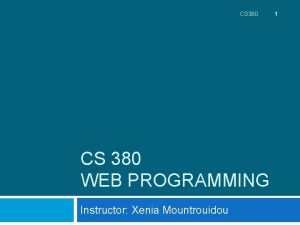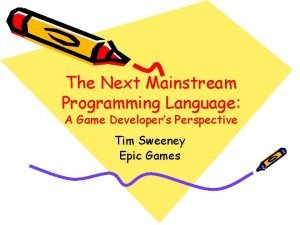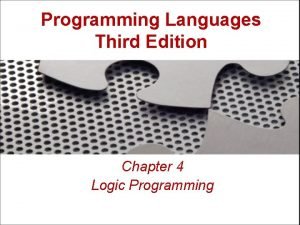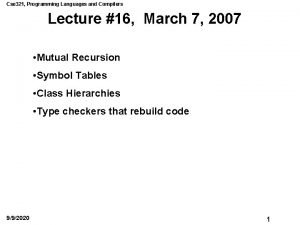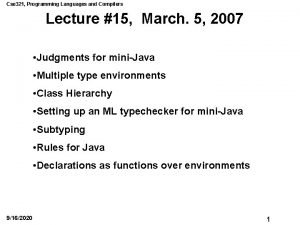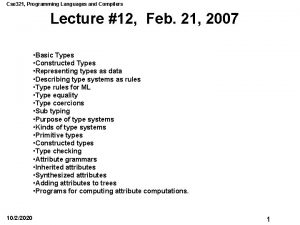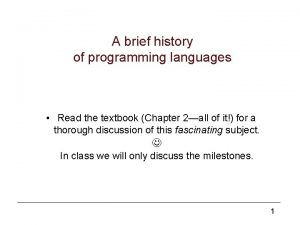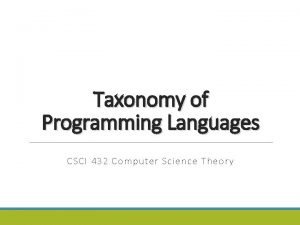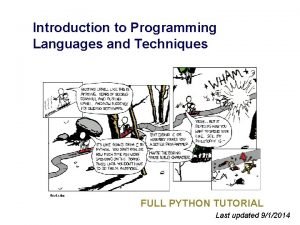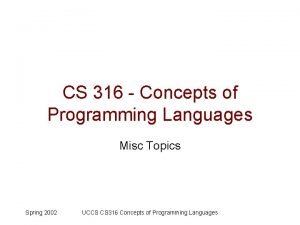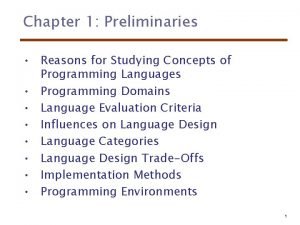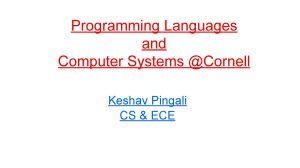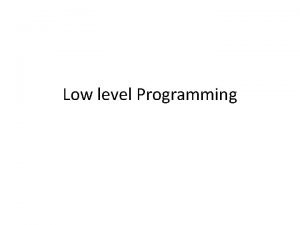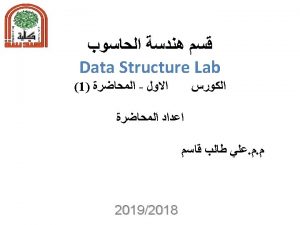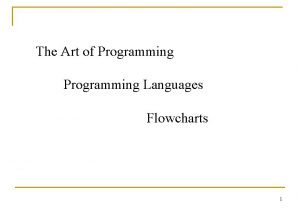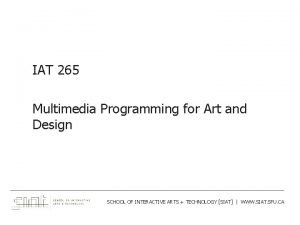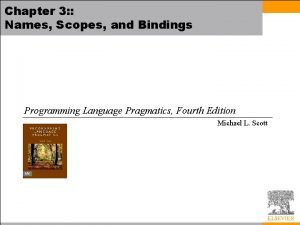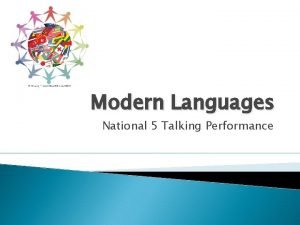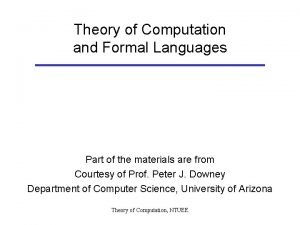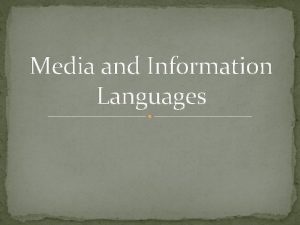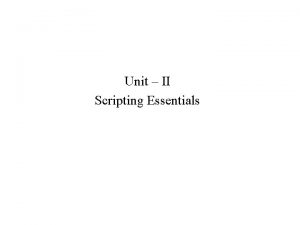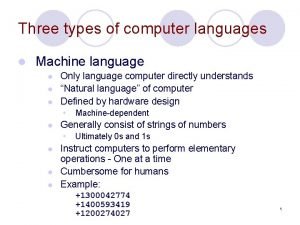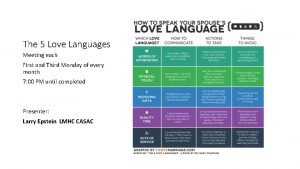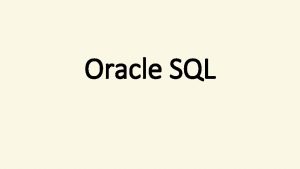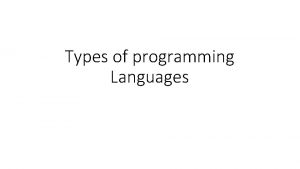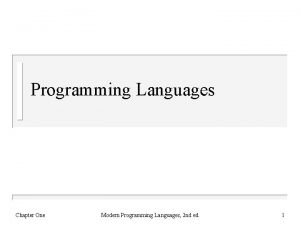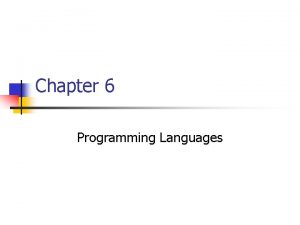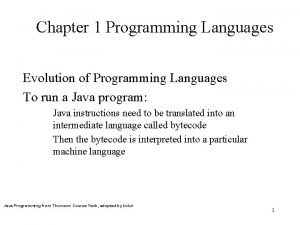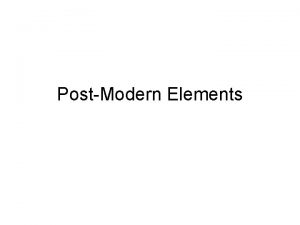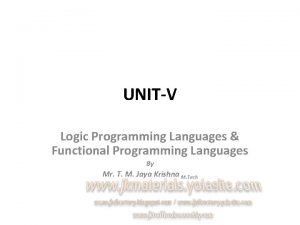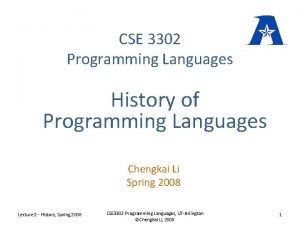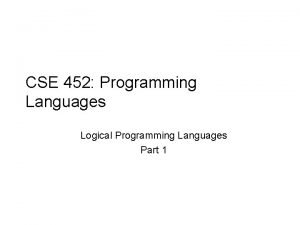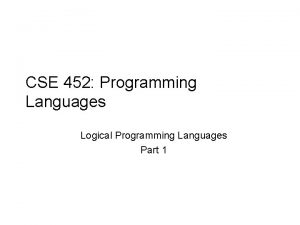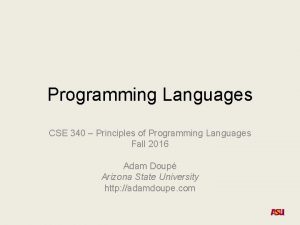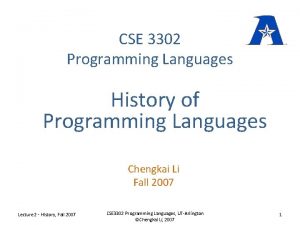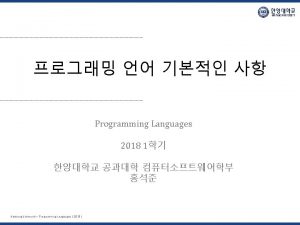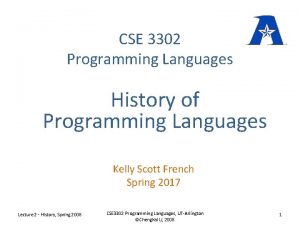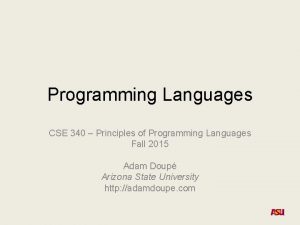Types Chapter Six Modern Programming Languages 1 Elements



















![Index Values Java, C, C++: ◦ First element of an array a is a[0] Index Values Java, C, C++: ◦ First element of an array a is a[0]](https://slidetodoc.com/presentation_image/4c3403eb4f8134c66399295050b3e801/image-20.jpg)
![Pascal Array Example type Letter. Count = array['a'. . 'z'] of Integer; var Counts: Pascal Array Example type Letter. Count = array['a'. . 'z'] of Integer; var Counts:](https://slidetodoc.com/presentation_image/4c3403eb4f8134c66399295050b3e801/image-21.jpg)































- Slides: 52

Types Chapter Six Modern Programming Languages 1

Elements of a Type Its set of values Its operations How its stored internally How its presented externally (printed) (Abstract Types just specify operations) Chapter Six Modern Programming Languages 2

A Type Is A Set int n; When you declare that a variable has a certain type, you are saying that the values the variable can have are elements of a certain set A type is a set of values ◦ with a low-level representation ◦ and an associated collection of operations that can be applied to those values Chapter Six Modern Programming Languages 3

Primitive vs. Constructed Types • Any type that a program can use but cannot define for itself is a primitive type in the language • Any type that a program can define for itself (using the primitive types) is a constructed (or structured) type • Some primitive types in ML: int, real, char • An ML program cannot define a type named int that works like the predefined int • A constructed type: int list • Defined using the primitive type int and the list type constructor Chapter Six Modern Programming Languages 4

Primitive Types The definition of a language says what the primitive types are Some languages define the primitive types more strictly than others: ◦ Some define the primitive types exactly (Java) ◦ Others leave some wiggle room—the primitive types may be different sets in different implementations of the language (C, ML) Chapter Six Modern Programming Languages 5

Comparing Integral Types C: char unsigned char short int unsigned int long int unsigned long int No standard implementation, but longer sizes must provide at least as much range as shorter sizes. Java: byte (1 -byte signed) char (2 -byte unsigned) short (2 -byte signed) int (4 -byte signed) long (8 -byte signed) Scheme: integer Integers of unbounded range Chapter Six Modern Programming Languages 6

Issues What sets do the primitive types signify? ◦ How much is part of the language specification, how much left up to the implementation? ◦ If necessary, how can a program find out? (INT_MAX in C, Int. max. Int in ML, etc. ) What operations are supported? ◦ Detailed definitions: rounding, exceptions, etc. The choice of representation is a critical part of these decisions Chapter Six Modern Programming Languages 7

Constructed Types Additional types defined using the language This chapter: enumerations, tuples, arrays, strings, lists, unions, subtypes, and function types For each one, there is connection between how sets are defined mathematically (in the abstract), and how types are defined in programming languages Chapter Six Modern Programming Languages 8

Making Sets by Enumeration Mathematically, we can construct sets by just listing all the elements: Chapter Six Modern Programming Languages 9

Making Types by Enumeration Many languages support enumerated types: C: Ada: Pascal: ML: enum coin {penny, nickel, dime, quarter}; These type GENDER is (MALE, FEMALE); type primary. Colors = (red, green, blue); datatype day = M | Tu | W | Th | F | Sa | Su; define a new type (= set) They also define a collection of named constants of that type (= elements) Chapter Six Modern Programming Languages 10

Representing Enumeration Values A common representation is to treat the values of an enumeration as small integers This may even be exposed to the programmer, as it is in C: enum coin { penny = 1, nickel = 5, dime = 10, quarter = 25 }; enum escapes { BELL = 'a', BACKSPACE = 'b', TAB = 't', NEWLINE = 'n', VTAB = 'v', RETURN = 'r' }; Chapter Six Modern Programming Languages 11

Operations on Enumeration Values Equality test: fun is. Weekend x = (x = Sa orelse x = Su); If the integer nature of the representation is exposed, a language will allow some or all integer operations: Pascal: for C : = red to blue do P(C) C: int x = penny + nickel + dime; Chapter Six Modern Programming Languages 12

Making Sets by Tupling The Cartesian product of two or more sets defines sets of tuples: Chapter Six Modern Programming Languages 13

Making Types by Tupling Some languages support pure tuples: fun get 1 (x : real * real) = #1 x; Many others support record types, which are just tuples with named fields: C: ML: struct complex { double rp; double ip; }; type complex = { rp: real, ip: real }; fun getip (x : complex) = #ip x; Chapter Six Modern Programming Languages 14

Representing Tuple Values A common representation is to just place the elements side-by-side in memory But there are lots of details: ◦ in what order? ◦ with “holes” to align elements (e. g. on word boundaries) in memory? ◦ is any or all of this visible to the programmer? ◦ See alignment. cpp Chapter Six Modern Programming Languages 15

Example: ANSI C The members of a structure have addresses increasing in the order of their declarations. A non-field member of a structure is aligned at an addressing boundary depending on its type; therefore, there may be unnamed holes in a structure. If a pointer to a structure is cast to the type of a pointer to its first member, the result refers to the first member… Adjacent field members of structures are packed into implementationdependent storage units in an implementation-dependent direction. . . The C Programming Language, 2 nd ed. Brian W. Kernighan and Dennis M. Ritchie Chapter Six Modern Programming Languages 16

Operations on Tuple Values Selection, of course: C: ML: x. ip #ip x Other operations depending on how much of the representation is exposed: C: double struct char } p 1 = y = *((double *) &x); person { *firstname; *lastname; {"marcia", "brady"}; Chapter Six Modern Programming Languages 17

Vectors Fixed-size vectors (arrays): Arbitrary-size vectors: Chapter Six Modern Programming Languages 18

Types Related To Vectors Arrays, Like strings and lists tuples, but with many variations One example: indexes ◦ What are the index values? ◦ Is the array size fixed at compile time? Chapter Six Modern Programming Languages 19
![Index Values Java C C First element of an array a is a0 Index Values Java, C, C++: ◦ First element of an array a is a[0]](https://slidetodoc.com/presentation_image/4c3403eb4f8134c66399295050b3e801/image-20.jpg)
Index Values Java, C, C++: ◦ First element of an array a is a[0] ◦ Indexes are always integers starting from 0 Pascal is more flexible: ◦ Various index types are possible: integers, characters, enumerations, subranges ◦ Starting index chosen by the programmer ◦ Ending index too: size is fixed at compile time Chapter Six Modern Programming Languages 20
![Pascal Array Example type Letter Count arraya z of Integer var Counts Pascal Array Example type Letter. Count = array['a'. . 'z'] of Integer; var Counts:](https://slidetodoc.com/presentation_image/4c3403eb4f8134c66399295050b3e801/image-21.jpg)
Pascal Array Example type Letter. Count = array['a'. . 'z'] of Integer; var Counts: Letter. Count; begin Counts['a'] = 1 etc. Note: This is not a map! Chapter Six Modern Programming Languages 21

Types Related To Vectors Many variations on vector-related types: What are the index values? Is array size fixed at compile time (i. e. , part of static type)? What operations are supported? Is re-dimensioning possible at runtime? Is it transparent? Are multiple dimensions allowed? Is a higher-dimensional array the same as an array of arrays? (C#) What is the order of elements in memory? (row vs. column) Is there a separate type for strings (not just array of characters)? Is there a separate type for lists (vs. arrays)? Chapter Six Modern Programming Languages 22

Making Sets by Union We can make a new set by taking the union of existing sets: Holds only one at a time. Chapter Six Modern Programming Languages 23

Making Types by Union Many languages support union types: C/C++: ML: union element { int i; float f; }; datatype element = I of int | F of real; Chapter Six Modern Programming Languages 24

Representing Union Values You can have the two representations overlap each other in memory union element { int i; char *p; } u; /* sizeof(u) == max(sizeof(u. i), sizeof(u. p)) */ C exposes this to the ◦ “loosely typed unions” See programmer also union. cpp Chapter Six Modern Programming Languages 25

Strictly Typed Unions In ML, all you can do with a union is extract the current contents And you have to say what to do with each type of value in the union: datatype element = I of int | F of real; fun get. Real (F x) = x | get. Real (I x) = real x; Chapter Six Modern Programming Languages 26

C Bit Fields struct Date { unsigned int day: 5; unsigned int mon: 4; unsigned int year: 7; }; See bit. cpp See also ieee. cpp Chapter Six Modern Programming Languages 27

A Middle Way: Variant Records Union where specific type is linked to the value of a field (“discriminated union”) A variety of languages including Ada, Modula-2, and D Chapter Six Modern Programming Languages 28

Ada Variant Record Example type DEVICE is (PRINTER, DISK); type PERIPHERAL(Unit: DEVICE) is record Hours. Working: INTEGER; case Unit is when PRINTER => Line_count: INTEGER; when DISK => Cylinder: INTEGER; Track: INTEGER; end case; end record; Chapter Six Modern Programming Languages 29

Making Subsets We can define the subset selected by any predicate P: Chapter Six Modern Programming Languages 30

Subtypes A type B is a subtype of another type A if: ◦ 1) Its values are a subset of the values of A ◦ 2) It supports all the same operations as A Another perspective: ◦ If elements of type B can be meaningfully substituted for elements of type A in all contexts requiring elements of A Inheritance is only one manifestation of subtyping Chapter Six Modern Programming Languages 31

Making Subtypes Some languages support subtypes, with more or less generality ◦ Less general: Pascal subranges type digit = 0. . 9; ◦ More general: Ada subtypes subtype DIGIT is INTEGER range 0. . 9; subtype WEEKDAY is DAY range MON. . FRI; ◦ Most general: Lisp types with predicates Chapter Six Modern Programming Languages 32

Example: Ada Subtypes type DEVICE is (PRINTER, DISK); type PERIPHERAL(Unit: DEVICE) is record Hours. Working: INTEGER; case Unit is when PRINTER => Line_count: INTEGER; when DISK => Cylinder: INTEGER; Track: INTEGER; end case; end record; subtype DISK_UNIT is PERIPHERAL(DISK); Chapter Six Modern Programming Languages 33

Example: Lisp Types with Predicates (declare (type integer x)) (declare (type (or null cons) x)) (declare (type (and number (not integer)) x)) (declare (type (and integer (satisfies evenp)) x)) Chapter Six Modern Programming Languages 34

Operations on Subtype Values Usually, supports all the same operations that are supported on the supertype And perhaps additional operations that would not make sense on the supertype: function to. Digit(X: Digit): Char; Important meditation: A subtype is a subset of values, but it can support a superset of operations. Chapter Six Modern Programming Languages 36

A Word About Classes In class-based object-oriented languages, a class can be a type: data and operations on that data are bundled together A subclass is a subtype: it includes a subset of the objects, but can support a superset of the operations Chapter Six Modern Programming Languages 37

Intrinsic Types Some languages use naming conventions to declare the types of variables ◦ Dialects of BASIC: S$ is a string ◦ Dialects of Fortran: I is an integer Like explicit annotations, these supply static type information to the language system and the human reader Chapter Six Modern Programming Languages 38

Extreme Type Inference ML takes type inference to extremes Infers a static type for every expression and for every function Usually requires no annotations Chapter Six Modern Programming Languages 39

Simple Type Inference Most languages require some simple kinds of type inference Literals usually have static types ◦ Java: 10 has type int, 10 L has type long Expressions may have static types, inferred from operators and types of operands ◦ Java: if a is double, a*0 is double (0. 0) Chapter Six Modern Programming Languages 40

Type Systems Have a set of rules for defining new types Have a set of rules that enforce correct behavior: ◦ type equivalence ◦ type compatibility e. g. , integers passed to real parameters subtypes passed to supertype parameters ◦ type inference Chapter Six Modern Programming Languages 41

Type Equivalence Name equivalence: types are the same if and only if they have the same name Structural equivalence: types are the same if and only if they: ◦ are built from the same primitive types using the same type constructors in the same order (i. e. , they have the same layout), or ◦ They have the same set of operations (independently) Chapter Six Modern Programming Languages, 2 nd ed. 42

Duck Typing “Structural Equivalence” “If it quacks like a duck…” ◦ Type name ignored Found in dynamically-typed languages ◦ Python, Ruby, Perl, PHP, Java. Script, etc. ◦ C++ templates ◦ C# using dynamic If a type has the needed operations in its context, then all is well ◦ Independent of type name or class hierarchy ◦ aka “structural equivalence” Chapter Six Modern Programming Languages 43

Type Checking Type checking ensures that a program obeys a language’s type compatibility rules Strong vs. weak type checking ◦ Strong typing means that no type violations are allowed Static vs. dynamic type checking ◦ Dynamic type checking happens at runtime ◦ Static type checking happens at compile time ◦ Some languages do both (Java, C#, C++) Chapter Six Modern Programming Languages 44

Static Type Checking Static type checking determines a type for everything before running the program: variables, functions, expressions, everything Compile-time error messages when static types are not consistent: ◦ Operators: 1+"abc" ◦ Functions: round("abc") ◦ Statements: if "abc" then … Many modern languages are statically typed Chapter Six Modern Programming Languages 45

Dynamic Typing In some languages, programs are not statically typechecked before being run They are usually still dynamically type-checked ◦ At runtime, the language system checks that operands are of suitable types for operators Chapter Six Modern Programming Languages 46

Example: Lisp This Lisp function adds two numbers: (defun f (a b) (+ a b)) It won’t work if a or b don’t support + An improper call, like (f nil), is not caught at compile time It is caught at runtime – that is dynamic typing Chapter Six Modern Programming Languages 47

It Still Uses Types Although dynamic typing does not type everything at compile time, it still uses types In a way, it uses them even more than ◦ It needs to have types to check at runtime static typing So the language system must store type information with the values in memory Chapter Six Modern Programming Languages 48

Static vs. Dynamic Typing Which is better? What types of programs are more suitable for one or the other? Chapter Six Modern Programming Languages 49

Static vs. Dynamic Typing Not quite a black-and-white picture Statically typing typed languages often use some dynamic ◦ Subtypes can cause this (runtime polymorphism) ◦ Everything is typed at compile time, but compile-time type may have subtypes ◦ At runtime, it may be necessary to check a value’s membership in a subtype ◦ This problem arises in object-oriented languages especially Chapter Six Modern Programming Languages 50

Explicit Runtime Type Tests Some languages allow explicit runtime type ◦ Java: test object type with instanceof operator ◦ C++: dynamic_cast tests: These require type information to be present at runtime, even when the language is mostly statically typed Chapter Six Modern Programming Languages 51

Strong Typing, Weak Typing The purpose of type-checking is to prevent the application of operations to incorrect types of operands In some languages, like ML and Java, the typechecking is thorough enough to guarantee this— that’s strong typing Many languages (like C) fall short of this: there are holes in the type system that add flexibility but weaken the guarantee: ◦ unions, varargs, pointer-array interoperability, reinterpret_cast Chapter Six Modern Programming Languages 52

Conclusion A key question for type systems: how much of the representation is exposed? Some programmers prefer languages like C that expose many implementation details ◦ They offer the power to cut through type abstractions, when it is useful or efficient (or fun) to do so Others prefer languages like ML that hide all implementation details (abstract types) ◦ Clean, mathematical interfaces make it easier to write correct programs, and to prove them correct Chapter Six Modern Programming Languages 53
 Types of programming languages
Types of programming languages Integral data type is
Integral data type is Real-time systems and programming languages
Real-time systems and programming languages Cs 421 uiuc
Cs 421 uiuc Thread dalam java
Thread dalam java Cxc it
Cxc it Introduction to programming languages
Introduction to programming languages Plc coding language
Plc coding language Procedural programming languages
Procedural programming languages Imperative programming languages
Imperative programming languages Alternative programming languages
Alternative programming languages Transmission programming languages
Transmission programming languages Cse 340 principles of programming languages
Cse 340 principles of programming languages Xenia programming languages
Xenia programming languages Advantages of application software
Advantages of application software Mainstream programming languages
Mainstream programming languages Cse 340 principles of programming languages
Cse 340 principles of programming languages Programing languages
Programing languages Programming languages
Programming languages Programming languages
Programming languages Programming languages
Programming languages Tiny programming language
Tiny programming language Brief history of programming languages
Brief history of programming languages Taxonomy of programming languages
Taxonomy of programming languages Real time programming language
Real time programming language High level language
High level language If programming languages were cars
If programming languages were cars Reasons for studying concepts of programming languages
Reasons for studying concepts of programming languages Cornell programming languages
Cornell programming languages Low level programming languages
Low level programming languages Middle level programming languages
Middle level programming languages The art of programming language
The art of programming language Cs 421 programming languages and compilers
Cs 421 programming languages and compilers Iat 265
Iat 265 Storage management in programming languages
Storage management in programming languages Languages for life and work
Languages for life and work Gcse modern foreign languages
Gcse modern foreign languages European center for modern languages
European center for modern languages National 5 modern languages talking performance
National 5 modern languages talking performance European center for modern languages
European center for modern languages Classify each polygon
Classify each polygon Perbedaan linear programming dan integer programming
Perbedaan linear programming dan integer programming Greedy vs dynamic
Greedy vs dynamic Windows 10 system programming, part 1
Windows 10 system programming, part 1 Linear vs integer programming
Linear vs integer programming Perbedaan linear programming dan integer programming
Perbedaan linear programming dan integer programming Theory of machines
Theory of machines What is media and information languages
What is media and information languages Types of languages
Types of languages What are the types of scripting language
What are the types of scripting language Types of machine languages
Types of machine languages Love languages chart
Love languages chart Types of database languages
Types of database languages













